I have traveled across many states in India and visited numerous tribes, experiencing their rituals, dances, and festivals. Each visit has offered a glimpse into the vibrant culture that binds these communities. This time, I want to explore the famous musical instruments of Indian tribes, to understand the sounds that echo through forests, mountains, and villages, and the role music plays in their daily lives.
Tribal instruments are not just tools for performance—they are a language, a connection to tradition, and a reflection of the land itself. From drums to flutes, strings, and small percussion instruments, each piece tells a story of celebration, spirituality, and community.
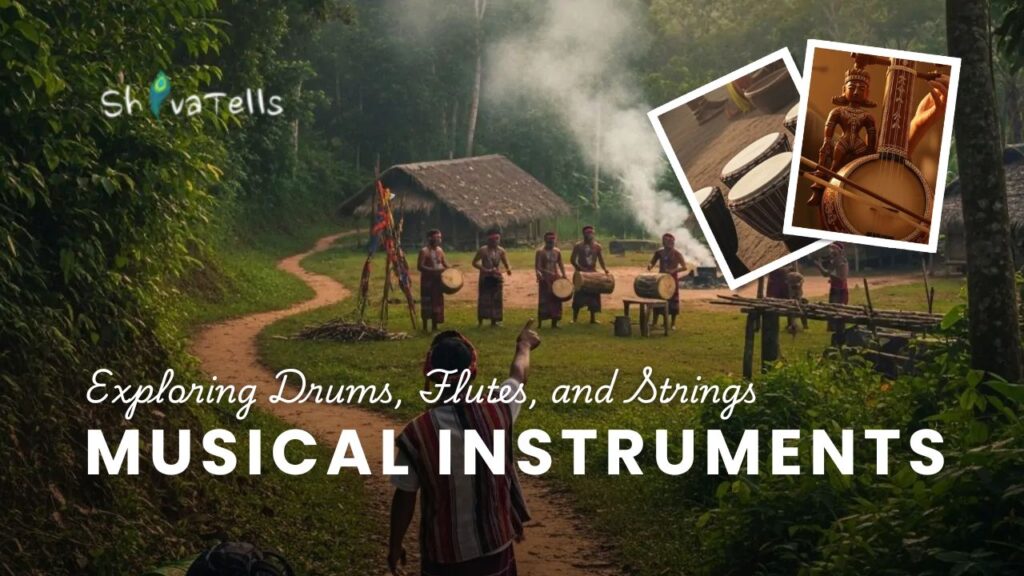
Table of Contents
Drums: The Pulse of Tribal Life
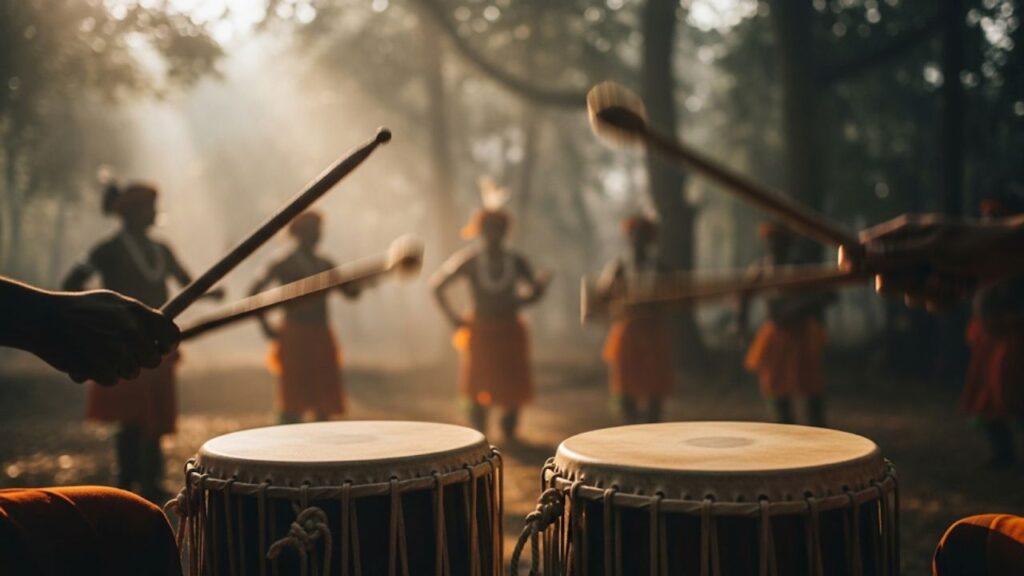
Drums form the heartbeat of tribal music. Among the Santal tribe, the Tumda is a double-sided drum, shaped like a frustum with animal skin stretched over both sides. One side produces a low, steady tone, while the other adds a sharper, higher note. The Tamak, hemispherical and played with sticks, creates deep, resonant rhythms that are essential to tribal dances and rituals.
In North India, the Dhol is widely used in festivals and ceremonies. Its loud, double-headed beats summon people and mark celebrations. In Himalayan tribal regions, the Madal delivers crisp, clear rhythms that guide dancers and keep the energy alive in community gatherings.
Other percussion instruments include the Mandar and Thiski, played by the Baiga tribe during social dances, as well as the Dama, a wooden hand drum common in Tripura and Meghalaya, and the Anandalhari, a clay bowl drum used in southern India. These drums, forming part of the famous musical instruments of Indian tribes, connect rhythm to culture and social life.
Wind Instruments: Songs That Travel
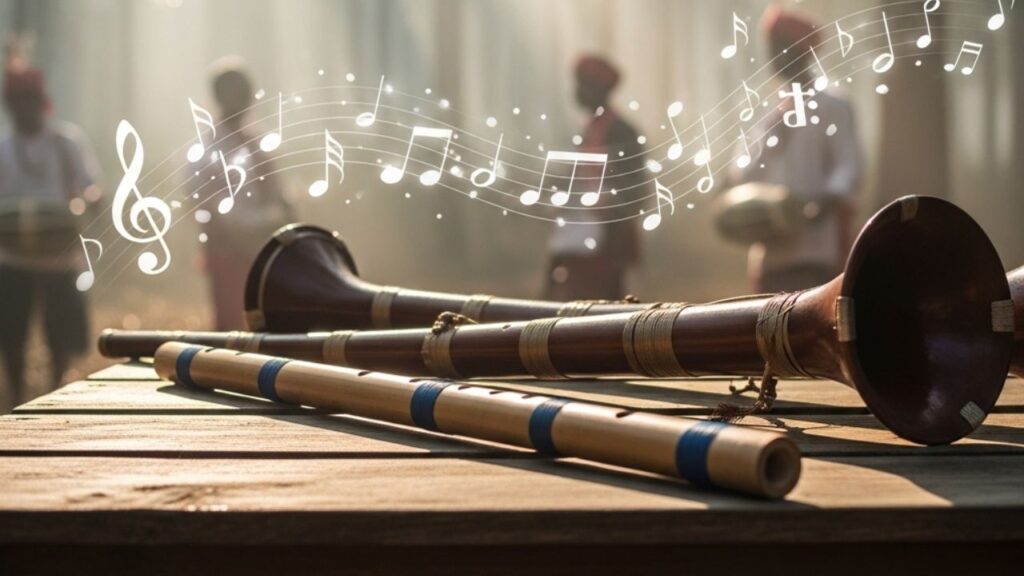
Wind instruments carry melodies that evoke nature, spirituality, and emotion. The Tiriao, often called a bamboo flute or Bansuri, is used by the Santal and other tribes. Its bamboo body with five to seven holes produces gentle, flowing tunes that accompany folk and ceremonial songs, linking people to the landscape around them.
In northern regions, the Shehnai is used in tribal rituals and celebrations, delivering piercing, celebratory tones. The Sharnai in Jammu & Kashmir performs a similar role during weddings and feasts. Both instruments are considered among the famous musical instruments of Indian tribes, giving sound to joy and tradition.
String Instruments: Stories in Melody
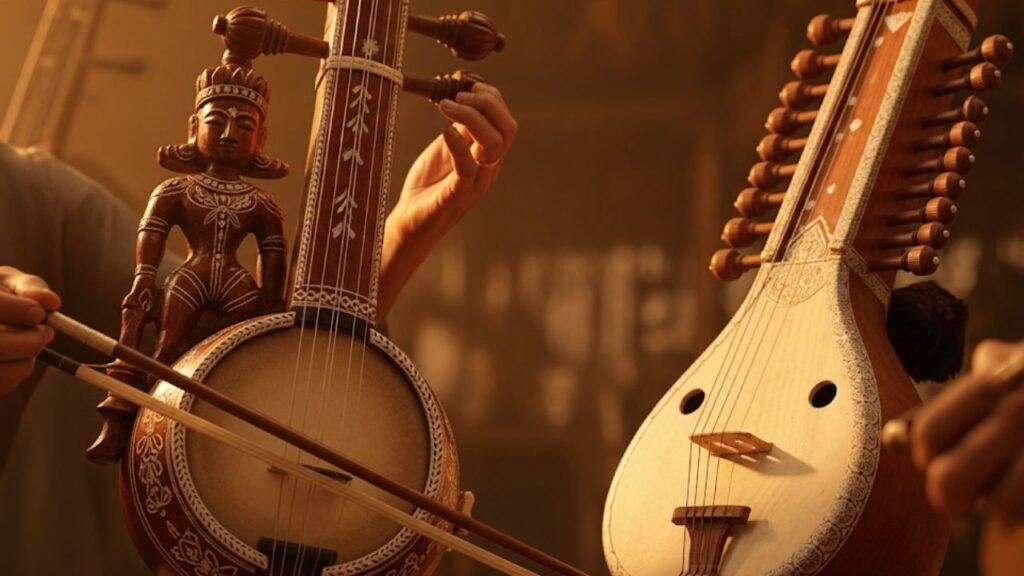
Stringed instruments carry both rhythm and narrative. The Dhodro Banam, native to the Santal tribe, is carved from a single piece of wood and covered with animal hide and lacquer. Often sculpted with human or animal heads, it is used in storytelling and ceremonial music.
The Ektara is a simple single-stringed instrument that provides a continuous drone for folk songs, while the Sarangi, a multi-string bowed instrument, accompanies vocals and narrative songs. Among the nomadic tribes of Jammu & Kashmir, the Yaktaro is a one-string wooden instrument used to accompany Sufi poetry and spiritual songs. Together, these stringed instruments form an essential part of the famous musical instruments of Indian tribes, preserving culture and history through sound.
Small Instruments, Big Impact: Rattles and Hand Percussion
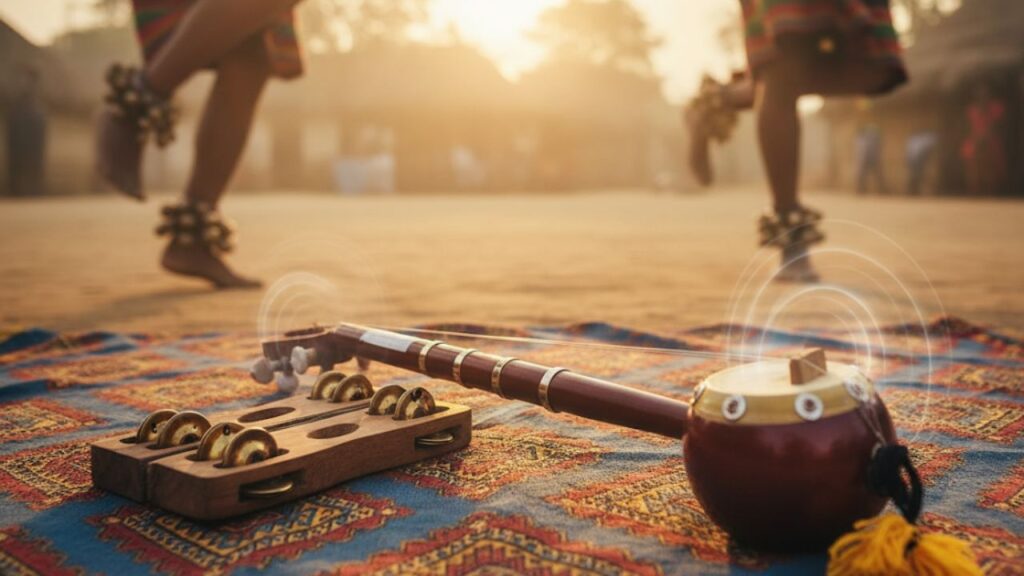
Not all tribal instruments are large or loud. Wooden Khartal clappers accentuate dance rhythms, while the Tumbi, a small plucked string instrument, adds liveliness to folk music.
In Baiga villages, the Mandar and Thiski work together during social gatherings. Hand drums like the Dama and clay bowl drums like the Anandalhari enrich tribal music, creating layers of rhythm that unify communities and enhance the spiritual and social dimensions of their culture. These are integral to the famous musical instruments of Indian tribes, showing how even small instruments can carry significant cultural weight.
Understanding Tribal Music: Culture Through Sound
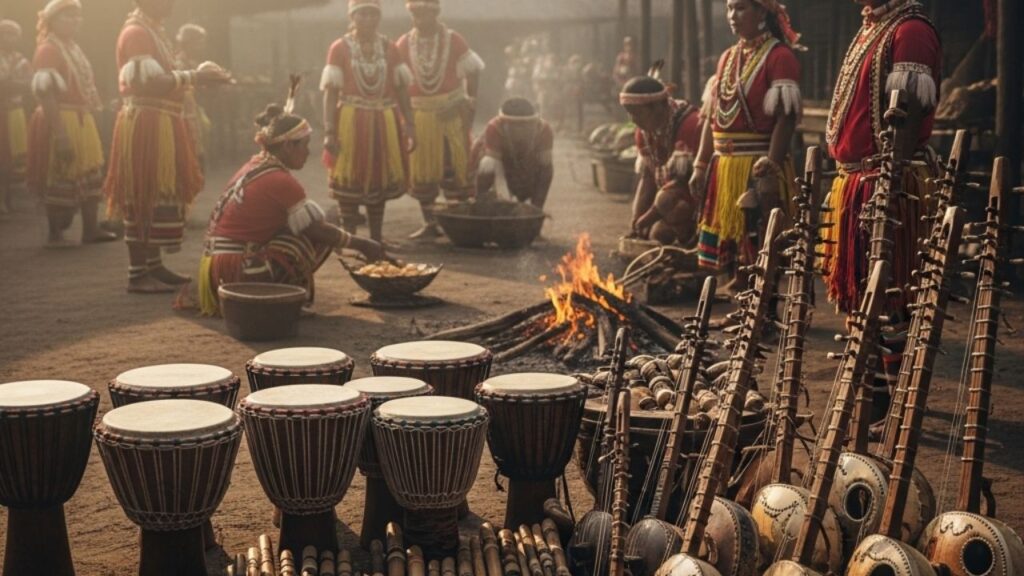
Through my travels, I have realized that tribal music is never just entertainment. Every drumbeat, flute note, and string vibration has a purpose. Drums announce celebrations and rituals, flutes connect humans to nature, and strings tell stories passed down through generations.
The materials used—wood, bamboo, animal skins, and clay—shape the sound and character of each instrument. The famous musical instruments of Indian tribes reflect the environment, climate, and lifestyle of the community that plays them. Exploring these instruments gives a sense of the rhythm of tribal life, and visiting these regions allows one to truly experience music as an essential part of community and identity.
Travel Tips: Experiencing Tribal Music
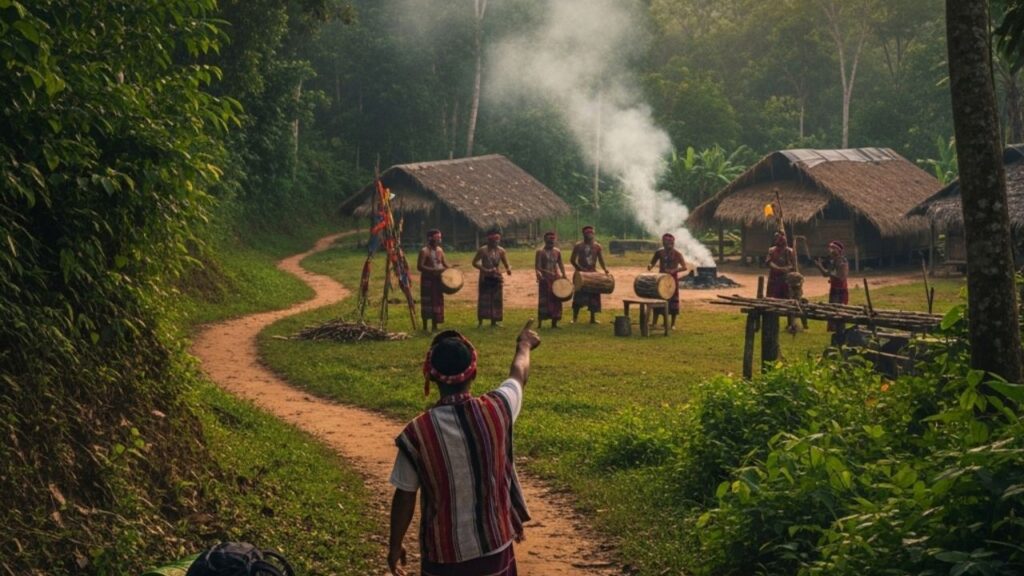
For anyone wanting to explore and feel the famous musical instruments of Indian tribes, here are some practical tips:
- Best Time to Visit:
- Santal villages in Jharkhand and West Bengal: October–February
- Northern and Himalayan tribes: November–March
- Tripura, Meghalaya, and southern tribal regions: October–March
- Average Budget: A week-long visit may cost ₹25,000–₹40,000, covering travel, homestays, guides, and food.
- Travel Mode: Reach major cities by train or flight. Villages are accessible via local buses, shared taxis, or jeeps. Hiring a local guide helps in accessing authentic performances and respecting tribal customs.
Top Travel Destinations Near Tribal Music Hubs
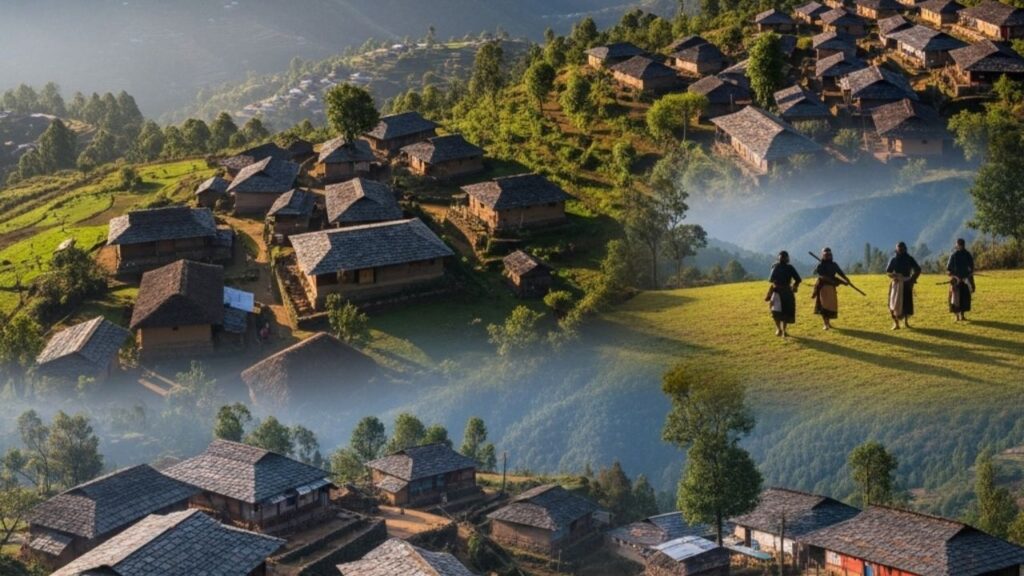
- Jharkhand & West Bengal (Santal Villages): Dumka, Jamshedpur outskirts, Purulia
- North India & Himalayan Regions: Himachal Pradesh (Kullu, Lahaul), Uttarakhand villages, Rajasthan
- Jammu & Kashmir Nomadic Routes: Pahalgam, Gulmarg during cultural fairs
- Tripura & Meghalaya: Agartala and Shillong, offering Dama and Anandalhari performances
- Baiga Tribe Regions: Satna and Mandla districts in Madhya Pradesh for Mandar and Thiski
Conclusion
I have visited many tribal communities and observed how music is deeply woven into life. The famous musical instruments of Indian tribes are more than tools—they are a bridge between generations, nature, and society. Drums, flutes, strings, and small percussion instruments each carry identity, history, and tradition.
Experiencing this music offers an opportunity to feel the pulse of tribal life, understand cultural narratives, and witness music as a living, breathing part of community. Every beat, note, and vibration tells a story, inviting anyone who visits to become part of that rhythm.
